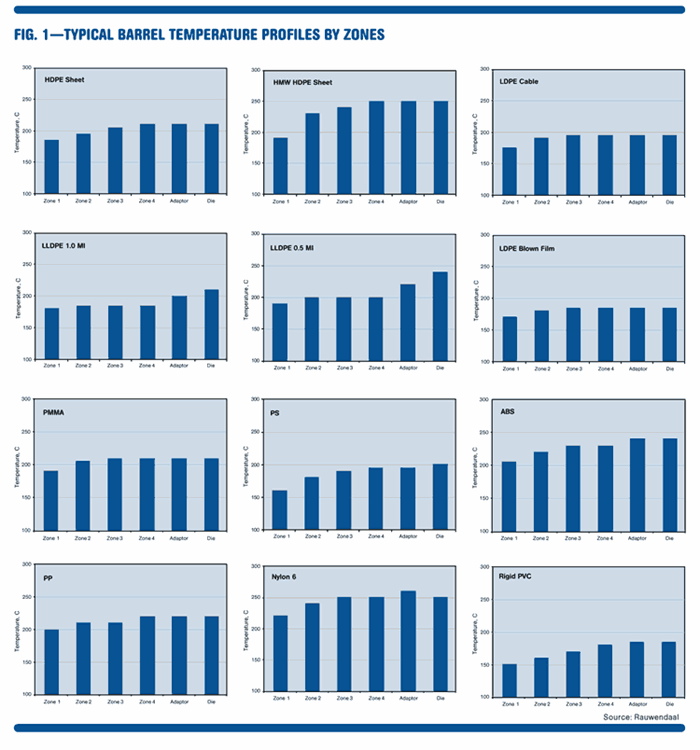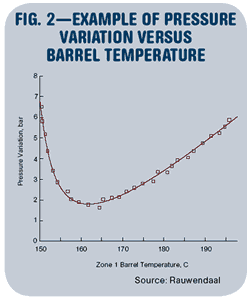TIME TO LEARN ABOUT Dynamic Optimization of Extruder Barrel Temperatures
Determining the optimum barrel-temperature profile is one of the most important tasks in extrusion.
Determining the optimum barrel-temperature profile is one of the most important tasks in extrusion. A barrel-temperature profile (BTP) that works well on one extruder may not work on the same type of extruder right next to it, even if the extruders process the same plastic, use the same screw and die design, and run at the same rpm. So in an extrusion plant with many extruders, trying to run them all at the same BTP will likely result in below-optimum performance for some extruders.
There are many possible reasons for this. One is the depth of temperature sensors in the barrel. If one extruder uses shallow-well thermocouples and another uses deep-well thermocouples, this will result in different temperatures on the inside wall of the barrel, where it really counts. The BTP is also affected by die head pressure, screw and barrel wear, ambient conditions (air temperature and humidity), and resin inlet temperature and moisture level.
Finding the correct BTP requires observing how the process reacts when changes occur. Some changes are intentional and obvious, such as a change in screw speed or barrel setpoint. A BTP that works well at 50 rpm screw speed may not work well at 120 rpm. When a new screw is installed in an extruder, particularly a screw with different flight geometry, the BTP will need adjustment.
Some process changes are unintentional and not necessarily obvious—for instance, when the extruder performance changes as a result of screw wear or buildup of contamination on the screen pack.
Start with these general temperature guidelines for the three major sections of the extruder—feed, transition, and metering. In the feed section, set barrel temperature to maximize motor load and minimize pressure variation at the die. In the transition section, set barrel temperature to minimize melt-temperature variation at the die. In the metering section, set barrel temperature to the manufacturer’s suggested melt temperature for the resin—but keep in mind that discharge melt temperature can be significantly higher than barrel temperatures in the metering section.
For a non-vented, single-stage extruder, the feed section consists of temperature zone 1 and sometimes part of zone 2. The metering section usually consists of the last two temperature zones. Temperature zones in between make up the transition section. Short extruders (24:1 to 26:1 L/D) usually have three or four zones in all. Longer extruders (30-32:1 L/D) typically have five to six zones, while long extruders (34:1 L/D and longer) may have six to 10 zones.
Typical processing temperatures for semi-crystalline plastics are generally about 50° to 75° C above the melting point of the resin. For instance, HDPE with a melting point of 130 C is typically processed at 180 to 205 C or higher. If the resin is susceptible to degradation, it may be processed closer to its melting point.
Amorphous plastics are usually processed about 100° C above their glass-transition temperature (Tg). For instance, PS with a Tg around 100 C is typically processed at around 200 C.
If standard or typical barrel-temperature profiles do not result in acceptable performance, the temperature settings will have to be optimized. The only technically correct way to find the best BTP is to perform a Design of Experiments (DOE) procedure incorporating all barrel-temperature zones. Ideally, this should be done with a full-factorial DOE because the various barrel-temperature zones can have interaction effects. A full-factorial DOE is reasonable when there are only three or four barrel zones. When a two-level factorial design is performed with four factors or barrel-temperature zones, this will require 16 (24) experiments. If each experiment takes 30 min, this will take a total of 8 hr—a full shift.
When there are five or more zones, a full-factorial DOE is too time-consuming and expensive to be practical in most situations, especially with a large extruder. For instance, a two-level factorial design with six factors or zones requires 64 experiments (26), each taking 30 min, for a total of 32 hr.
Therefore, the One-at-a-Time Experiments (OTE) method is the most commonly used way to optimize BTP. It usually uses small (5° C) temperature changes. But this method is also slow and expensive. Each time a temperature change is made, you have to wait until the barrel zone reaches setpoint and the extruder stabilizes. Reaching setpoint can take 5 to 10 min on a small (20- to 40-mm) extruder or 30 to 60 min on a large extruder (over 100 mm diam.). It can take another 5 to 10 min for a small extruder to stabilize, or 30 to 60 min for a large extruder. So making five or six changes can take an entire day or longer for a large extruder. The OTE method also cannot uncover interaction effects.
WHY DYNAMIC OPTIMIZATION
A third method of optimizing BPT is Dynamic Optimization, which involves making large temperature changes (20 to 40° C or more) and tracking the dynamic response of the extruder. This method is a fast but robust method of barrel-temperature optimization that works even for very large extruders operating in a production environment. This method has been used for many years, and proven effective in a wide variety of extrusion operations, though it still isn’t widely enough known.
When the setpoint of a barrel-temperature zone is changed by large amounts, the temperature-control system may not achieve the set temperature. For instance, if the setpoint for zone 3 is changed from 220 C down to 160 C, actual barrel temperature may only go down to 184 C. If the cooling system is on full blast at this condition, the barrel temperature cannot be reduced further even if the setpoint is put much lower. The only way to achieve further temperature reduction would be to increase cooling capacity or to change process conditions like reducing screw speed.
As an example of Dynamic Optimization on a 100-mm extruder, suppose zone 1 barrel temperature is changed from 200 C down to 150 C. It may take the extruder 15 to 20 min to bring the actual barrel temperature down to 150 C. With Dynamic Optimization the actual barrel temperature is recorded every 15 to 30 sec, or whatever time interval allows accurate determination of the extruder’s behavior. (When a data-acquisition system is available, the data are recorded automatically with a sampling frequency high enough to record the transient behavior accurately.)
At each barrel-temperature recording, the corresponding melt-pressure variation is recorded. This allows construction of a graph of pressure variation versus barrel temperature. The lowest pressure variation is reached at between 160 C and 165 C. The pressure variation increases rapidly at temperatures below 155 C and less rapidly above 170 C. That means that zone 1 temperature should be set at 165 C to avoid the steep part of the curve between 150 C and 155 C.
It is possible that under steady-state conditions, the pressure variation is not the same as under transient conditions. If the steady-state pressure variation at 165 C is much higher than the transient pressure variation, it may be necessary to do a few OTE runs around 165 C. In most cases, however, this won’t be necessary, and the extruder will run well at the setpoint determined by Dynamic Optimization.
Zone 1 barrel temperature in many cases has the strongest effect on extrusion process stability. So it is often not necessary to do further experiments with the BTP. In a 100-mm extruder, therefore, it may be possible to determine the optimum BTP in less than an hour.
ABOUT THE AUTHOR
Chris Rauwendaal has worked in extrusion for 35 years. He heads his own engineering firm in Auburn, Calif., which provides custom screws and dies, training, and process troubleshooting services. The author welcomes readers’ questions or comments by e-mail at chris@rauwendaal.com.
Related Content
Troubleshooting Screw and Barrel Wear in Extrusion
Extruder screws and barrels will wear over time. If you are seeing a reduction in specific rate and higher discharge temperatures, wear is the likely culprit.
Read MoreThe Importance of Barrel Heat and Melt Temperature
Barrel temperature may impact melting in the case of very small extruders running very slowly. Otherwise, melting is mainly the result of shear heating of the polymer.
Read MorePart 2 Medical Tubing: Use Simulation to Troubleshoot, Optimize Processing & Dies
Simulation can determine whether a die has regions of low shear rate and shear stress on the metal surface where the polymer would ultimately degrade, and can help processors design dies better suited for their projects.
Read MoreReduce Downtime and Scrap in the Blown Film Industry
The blown film sector now benefits from a tailored solution developed by Chem-Trend to preserve integrity of the bubble.
Read MoreRead Next
For PLASTICS' CEO Seaholm, NPE to Shine Light on Sustainability Successes
With advocacy, communication and sustainability as three main pillars, Seaholm leads a trade association to NPE that ‘is more active today than we have ever been.’
Read MoreSee Recyclers Close the Loop on Trade Show Production Scrap at NPE2024
A collaboration between show organizer PLASTICS, recycler CPR and size reduction experts WEIMA and Conair recovered and recycled all production scrap at NPE2024.
Read MoreMaking the Circular Economy a Reality
Driven by brand owner demands and new worldwide legislation, the entire supply chain is working toward the shift to circularity, with some evidence the circular economy has already begun.
Read More
















